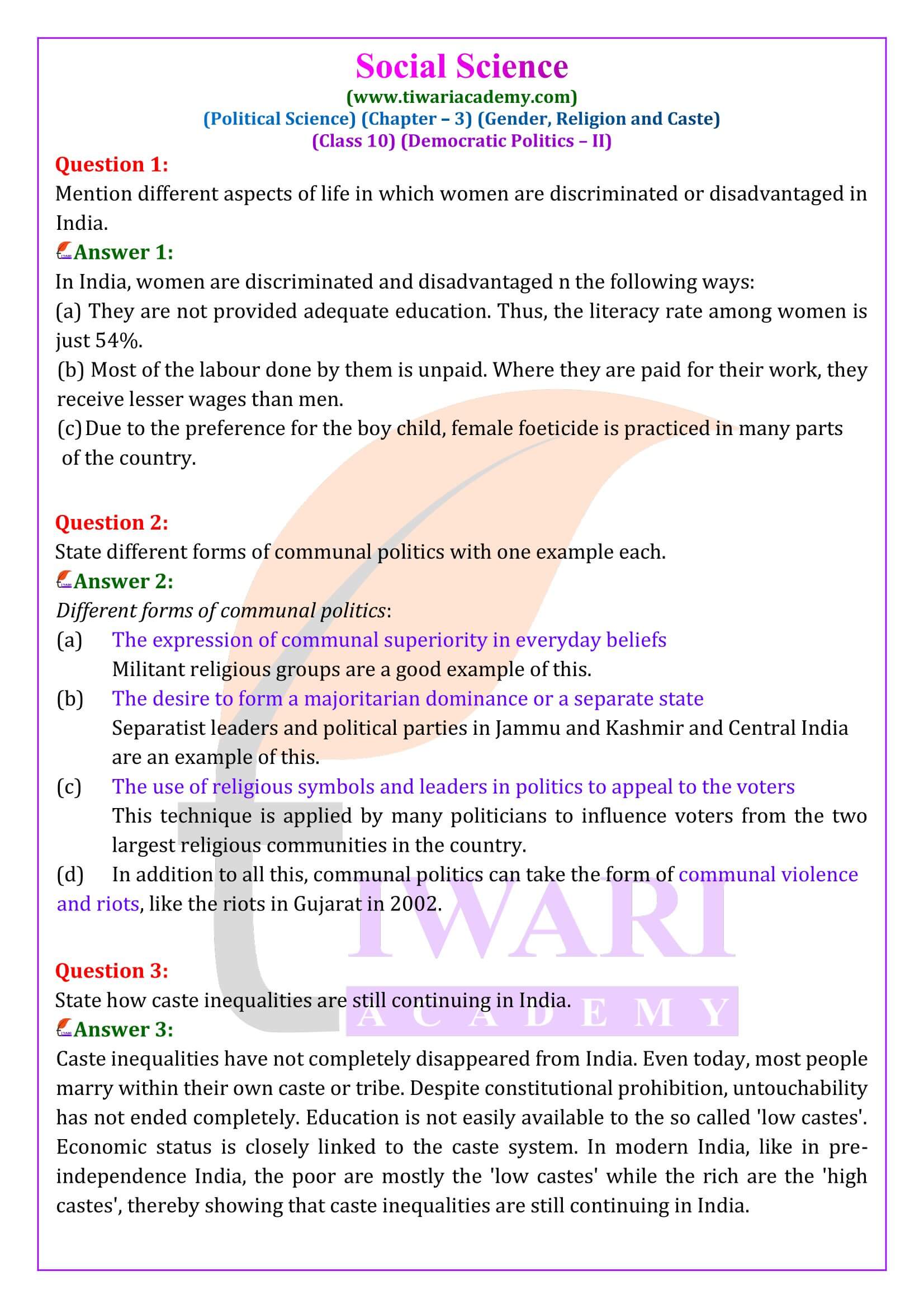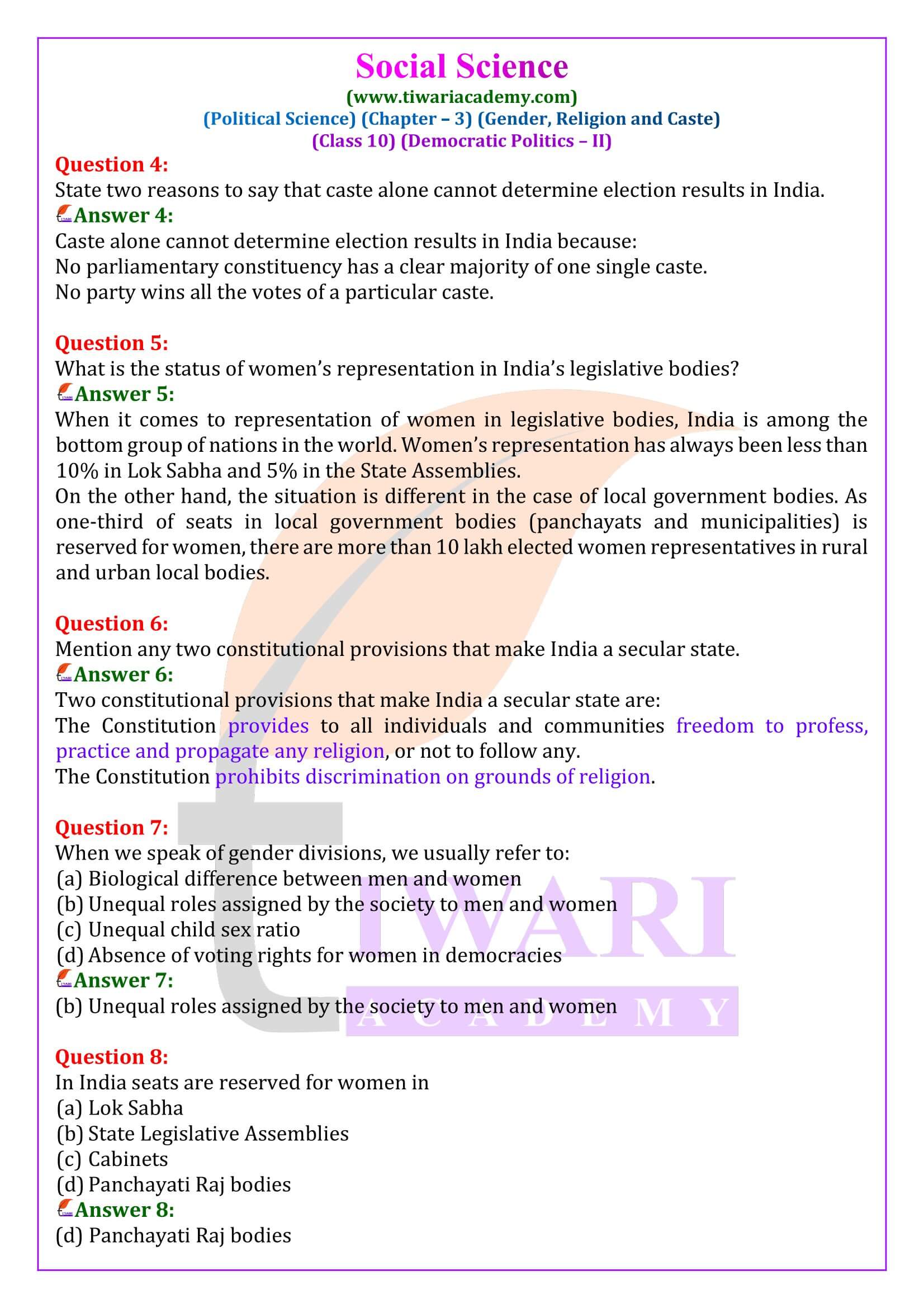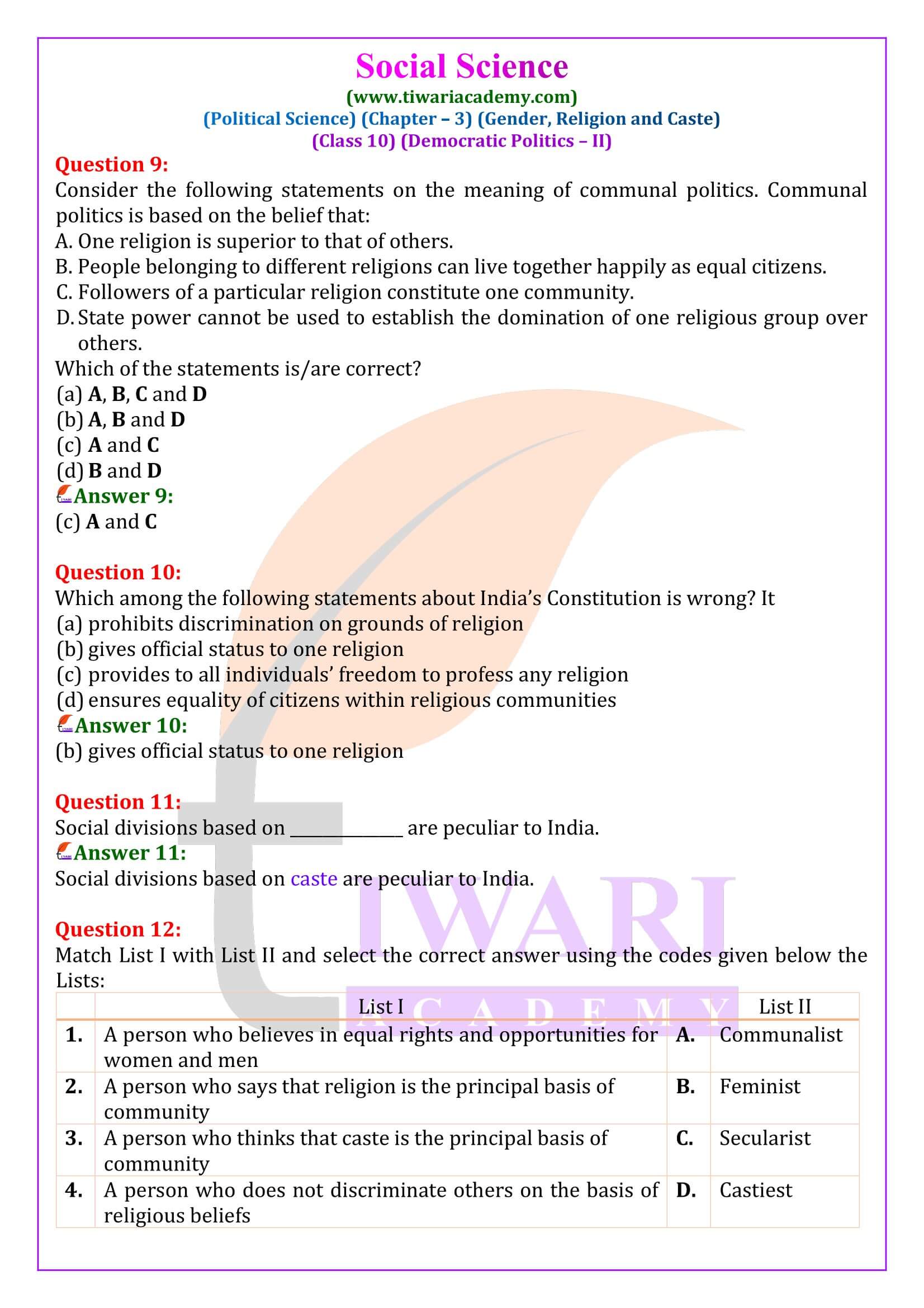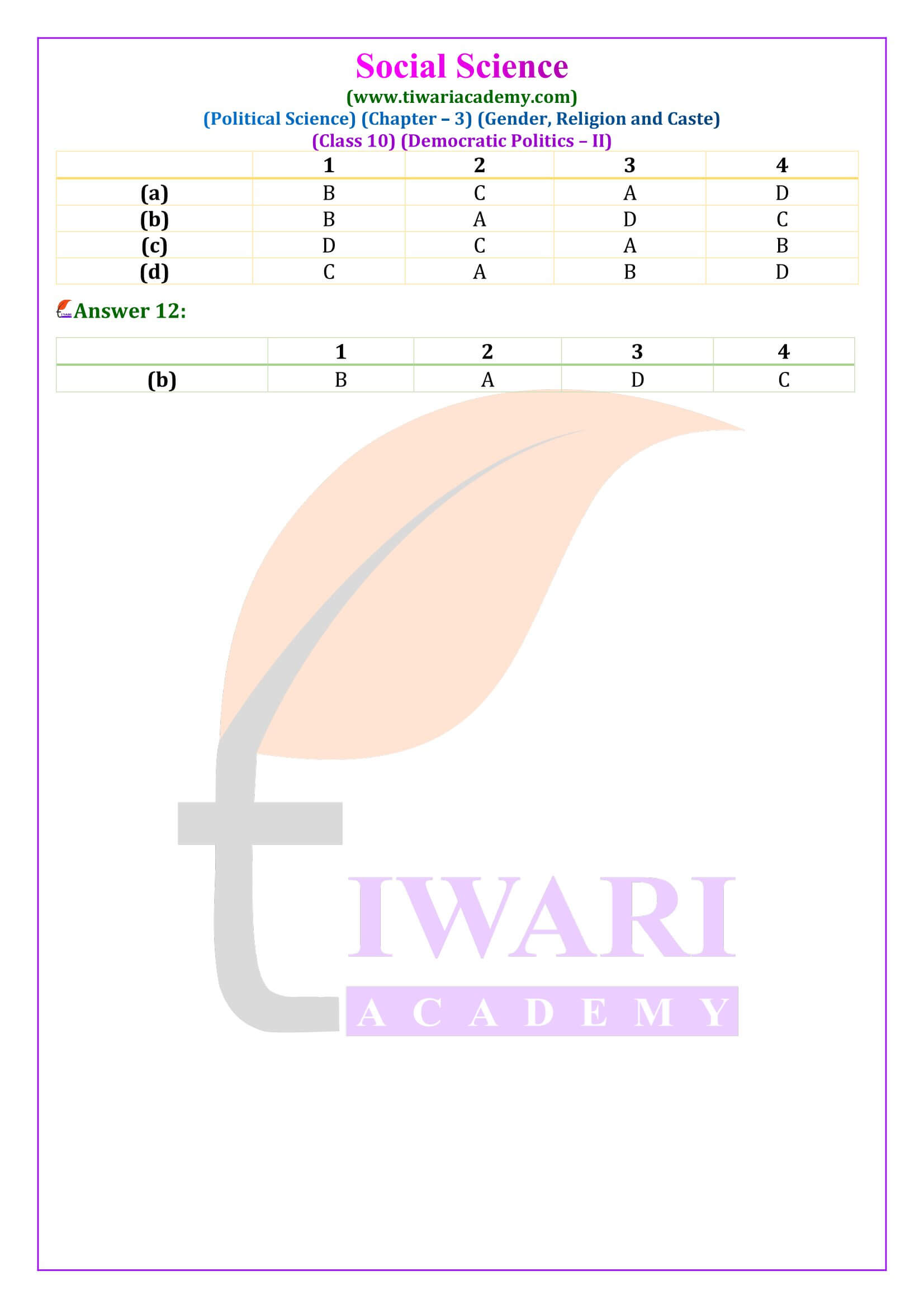NCERT Solutions for Class 10 Political Science Chapter 3 Gender, Religion and Caste in English and Hindi Medium for academic session 2024-25. The solutions of political science chapter 3 in 10th Social Science are revised and modified according to rationalised NCERT books issued for 2024-25 exams.
NCERT Solutions for Class 10 Civics Chapter 3
NCERT Solutions for Class 10 Civics Chapter 3
| Class: 10 | Political Science |
| Subject: | Social Science – Civics |
| Chapter 3: | Gender, Religion and Caste |
| Academic Session: | 2024-25 |
NCERT Solutions for Class 10 Civics Chapter 3
NCERT Solutions for Class 10 Civics Chapter 3 in PDF updated for new academic session 2024-25 based on latest CBSE Syllabus. Download NCERT Books and Offline Apps for offline use. Ask your questions related to yours curriculum or general awareness in Discussion Forum to get proper answers.
Exatra Questions Class 10 Civics Chapter 3
In the 1968 Olympics, Smith and Carless won the gold and bronze medals respectively. They received their medals wearing black socks and no shoes, to represent Black poverty. With this gesture, they tried to draw international attention to racial discrimination in the United States.
It is fairly common for people belonging to the same religion to feel that they do not belong to the same community, because their caste or sect is very different. It is also possible for people from different religious to have the same caste and feel close to each other. Rich and poor persons from the same family often do not keep close relations with each other for they feel they are different. For Example: Carlos and Smith were similar in one way that they both were Afro-Americans and thus different from Norman, who was white. But they were all athletes who stood against racial discrimination. Thus we all have more than one social group.
What is meant by Secularism?
The belief that religion should not be involved with the ordinary social and political activity of a country.
What is Caste hierarchy?
A social structure in which classes are determined by heredity i.e. from the highest to the lowest castes.
What do you know about Communalism?
It is a belief in which the followers of a particular religion believe that their religion is superior over other religion.
Politics by Cast
According to NCERT Books for class 10 Social Science, form of politics by cast are as follows:
(i) Sometimes candidates are chosen on the basis of their caste. When political parties choose candidates, they keep in mind the caste composition of their voters.
(ii) In many places, voters vote on the basis of caste and fail to choose suitable candidates.
(iii) When a government is formed after elections, political parties take care that different castes are represented in the government.
(iv) Political parties appeal to caste sentiments during elections.
(v) To gain support, political parties, raise caste-based issues during elections.
(vi) The castes considered inferior or low until now have been made conscious of their rights by the political parties.
One Mark Questions with Answers
Important Questions other than NCERT Solutions:
1. What do you mean by homogenous society?
2. Name the Indian states where according to the census of 2001, sex ratio is less than 800.
3. According to 2001 census what was the sex ration in India?
4. Name the Australian Athlete, who supported the two American athletes.
5. Who said that religion can never be separated from politics?
6. What was the main aim of Civil rights movements in the USA?
7. Which kind of social differences create possibilities of deep social divisions and tensions?
8. Which state in India has the lowest infant mortality rate?
9. What is meant by Sex ratio?
10. Give examples of two countries having homogeneous Society.
Answers of 1 Mark Questions
1. A society where there are not significant ethnic differences.
2. Punjab, Haryana, Himachal Pradesh & Gujrat
3. 1000 males 933 females
4. Peter Norman
5. Mahatma Gandhi
6. To abolish legal racial discrimination.
7. Overlapping social differences
8. Kerala
9. Sex ratio means number of females per thousand males in a country.
10. Germany and Sweden.
Important Questions on Class 10 Civics Chapter 3
State different forms of communal politics with one example each.
Different forms of communal politics: (a) The expression of communal superiority in everyday beliefs: Militant religious groups are a good example of this. (b) The desire to form a majoritarian dominance or a separate state: Separatist leaders and political parties in Jammu and Kashmir and Central India are an example of this. (c) The use of religious symbols and leaders in politics to appeal to the voters: This technique is applied by many politicians to influence voters from the two largest religious communities in the country. (d) In addition to all this, communal politics can take the form of communal violence and riots, like the riots in Gujarat in 2002.
State how caste inequalities are still continuing in India.
Caste inequalities have not completely disappeared from India. Even today, most people marry within their own caste or tribe. Despite constitutional prohibition, untouchability has not ended completely. Education is not easily available to the so called ‘low castes’. Economic status is closely linked to the caste system. In modern India, like in pre-independence India, the poor are mostly the ‘low castes’ while the rich are the ‘high castes’, thereby showing that caste inequalities are still continuing in India.
Mention different aspects of life in which women are discriminated or disadvantaged in India.
In India, women are discriminated and disadvantaged n the following ways: (a) They are not provided adequate education. Thus, the literacy rate among women is just 54%. (b) Most of the labour done by them is unpaid. Where they are paid for their work, they receive lesser wages than men. (c) Due to the preference for the boy child, female foeticide is practiced in many parts of the country.
State two reasons to say that caste alone cannot determine election results in India.
Caste alone cannot determine election results in India because: No parliamentary constituency has a clear majority of one single caste. No party wins all the votes of a particular caste.
What is the status of women’s representation in India’s legislative bodies?
When it comes to representation of women in legislative bodies, India is among the bottom group of nations in the world. Women’s representation has always been less than 10% in Lok Sabha and 5% in the State Assemblies. On the other hand, the situation is different in the case of local government bodies. As one-third of seats in local government bodies (panchayats and municipalities) is reserved for women, there are more than 10 lakh elected women representatives in rural and urban local bodies.
Mention any two constitutional provisions that make India a secular state.
Two constitutional provisions that make India a secular state are: The Constitution provides to all individuals and communities freedom to profess, practice and propagate any religion, or not to follow any. The Constitution prohibits discrimination on grounds of religion.






